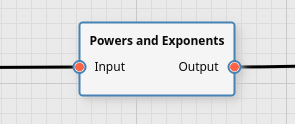Powers and Exponents Filter
The powers and exponents filter applies a unary operation (such as performing exponentiation) to all individual coefficients of a data set.
Category |
|
Node |
|
Parameters |
Operation Type: which operation to perform (see below) X: a number that is used as a parameter for some operations |
Inputs |
Input: the input of the operation |
Outputs |
Output: the result of the operation |
Effect of the Filter
The filter performs one of the following operations on each individual scalar value of the input:
Negate: inverts the sign of the value (
), e.g.
becomes
and
becomes
.
Invert: calculates the inverse value (
), e.g.
becomes
and
becomes
.
Natural Log: calculates the natural logartihm (basis
;
), e.g.
becomes
, and
becomes approximately
.
Natural Exp: calculates the exponential function (
), i.e.
becomes approximately
and
becomes approximately 22026.
Decimal Log: calculates the logartihm of basis 10 (
), e.g.
becomes
, and
becomes
.
Decimal Exp: calculates 10 to the power of the input (
), e.g.
becomes
and
becomes
.
Negative Decimal Log: calculates the negation of the logartihm of basis 10 (
), e.g.
becomes
, and
becomes
. (This can be used to convert reflectances into abundances.)
Decimal Exp of Negative: calculates 10 to the power of the input negated (
), e.g.
becomes
and
becomes
. (This can be used to convert abundances into reflectances.)
Binary Log: calculates the logartihm of basis 2 (
), e.g.
becomes
, and
becomes
.
Binary Exp: calculates 2 to the power of the input (
), e.g.
becomes
and
becomes
.
Square: calculates the square of the input (
), e.g.
becomes
and
becomes
.
Square Root: calculates the square root of the input (
), e.g.
becomes
, and
becomes
.
Generic Log: calculates a generic logartihm to the basis of the supplied parameter X of the input (X must be positive and not equal to 1,
), e.g.
becomes
if X is
.
Generic Exp: calculates the supplied parameter X raised to the power of the input (X must be non-negative,
), e.g.
becomes
if X is
.
Generic Power: calculates the input raised to the power of the supplied parameter X (
), e.g.
becomes
if X is
.
Note
The result of this operation may be NaN (not a number) or infinity if the input data has certain values. Notably, a fractional power of a negative input will give NaN (this includes the square root operation); the inverse of 0 will give infinity.
